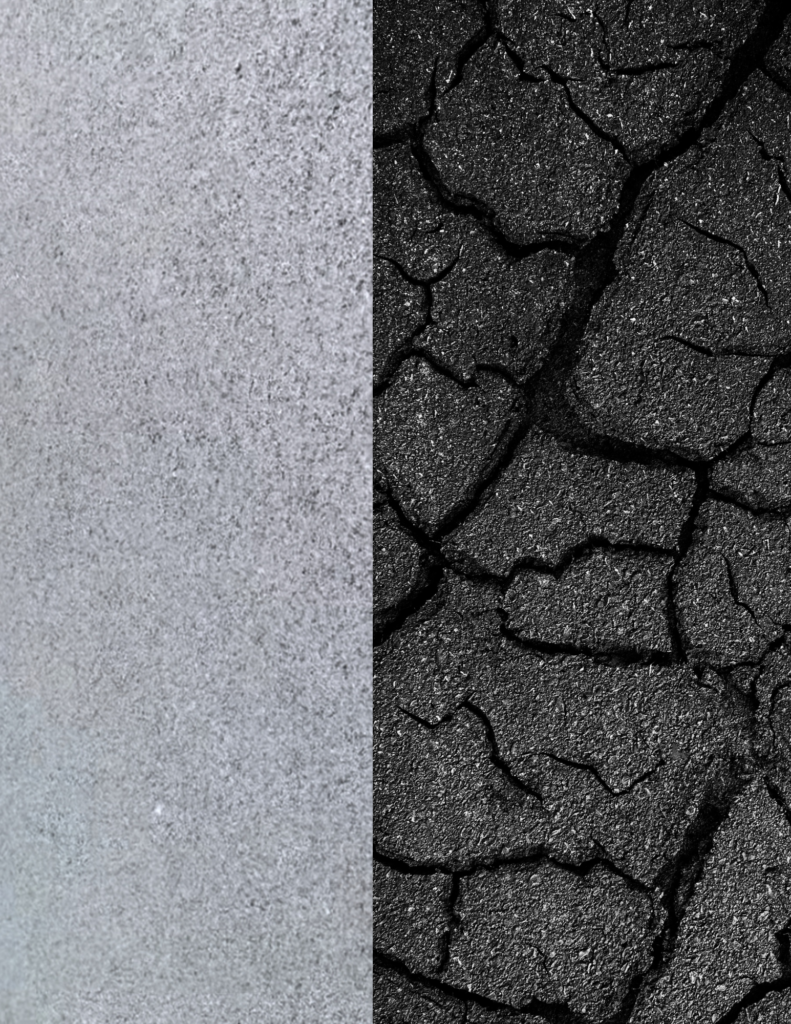
Maintaining asphalt pavement is crucial for the longevity and safety of your surfaces. Various types of asphalt damage can occur over time, each with its own causes and solutions. We’ll explore common asphalt damage types, the underlying factors contributing to pavement damage, and effective strategies to address these issues. Understanding these types of asphalt issues will help you implement better maintenance practices and prolong the life of your pavement.
Types of Asphalt Damage
1. Cracking
Alligator Cracking
Alligator cracking is characterized by a series of interconnected cracks resembling alligator skin. This severe type of asphalt damage indicates structural failure and requires prompt attention.
Causes:
- Heavy loads on weak spots
- Inadequate base support
- Poor drainage
Solutions:
- Full-depth patching: Remove the damaged area and replace it with new asphalt.
- Overlaying: Apply a new layer of asphalt over the existing surface if the damage is not extensive.
Linear Cracking
Linear cracks run parallel or perpendicular to the pavement’s centerline. These cracks often result from aging and stress due to temperature changes.
Causes:
- Temperature fluctuations causing expansion and contraction
- Poor construction practices
Solutions:
- Crack sealing: Fill the cracks with sealant to prevent water infiltration.
- Crack filling: Use asphalt emulsion to fill and seal the cracks.
2. Potholes
Potholes are depressions in the pavement surface caused by the removal of surface material. They pose a significant risk to vehicles and pedestrians.
Causes:
- Water infiltration through cracks
- Freeze-thaw cycles causing expansion and contraction
- Traffic load exacerbating the weakened areas
Solutions:
- Cold patch: A temporary fix using cold-mix asphalt.
- Hot patch: A more permanent solution with hot-mix asphalt.
- Full-depth patching: For extensive damage, remove and replace the affected area.
3. Rutting
Rutting refers to depressions or grooves in the wheel paths, often leading to a bumpy ride and water accumulation.
Causes:
- Insufficient compaction during construction
- Weak subgrade unable to support heavy loads
- Heavy traffic causing deformation
Solutions:
- Overlaying: Apply a new layer of asphalt to level the surface.
- Milling and filling: Remove the damaged asphalt and replace it with new material.
4. Raveling
Raveling is the loss of aggregate from the pavement surface, leading to a rough texture and decreased structural integrity.
Causes:
- Aging: Asphalt binder oxidizing and losing flexibility
- Poor quality mix used during construction
Solutions:
- Sealcoating: Apply a protective layer to seal the surface and prevent further aggregate loss.
- Resurfacing: Lay a new layer of asphalt over the affected area.
5. Depressions
Depressions, or bird baths, are low areas on the pavement that hold water. They can lead to further damage if not addressed.
Causes:
- Settlement of the subgrade
- Inadequate compaction during construction
- Poor drainage
Solutions:
- Leveling: Fill the low areas with asphalt to restore the surface.
- Improving drainage: Install proper drainage systems to prevent water accumulation.
6. Edge Cracking
Edge cracks occur along the outer edges of the pavement. These cracks can spread and cause further deterioration if not addressed.
Causes:
- Heavy traffic near the edges
- Poor support at the pavement edges
- Erosion of the base layer
Solutions:
- Crack sealing: Fill the cracks with a suitable sealant.
- Edge strengthening: Improve support along the pavement edges with additional materials.
7. Bleeding
Bleeding happens when excess asphalt binder rises to the surface, creating a shiny, sticky layer. This condition can reduce skid resistance and pose a safety hazard.
Causes:
- Excessive asphalt binder in the mix
- High temperatures causing the binder to soften and rise
Solutions:
- Sand application: Spread sand over the bleeding area to absorb the excess binder.
- Milling: Remove the surface layer and apply a new layer of asphalt with the correct binder content.
Preventive Measures for Asphalt Maintenance
Regular Inspections
Conduct regular inspections to identify potential issues early. Look for:
- Cracks and potholes: Address these issues before they worsen.
- Surface wear: Monitor for signs of raveling or depressions.
Sealcoating
Sealcoating provides a protective layer that shields the asphalt from UV rays, water, and chemicals, extending the pavement’s lifespan and enhancing its appearance.
Proper Drainage
Ensure proper drainage to prevent water from infiltrating the pavement. This includes:
- Cleaning gutters and drains: Regularly remove debris from drainage systems.
- Regrading: Adjust the slope of the pavement to facilitate water flow.
Load Management
Limit the weight of vehicles on your pavement to prevent overloading. This can be achieved by:
- Restricting heavy vehicles: Designate specific areas for heavy traffic.
- Weight distribution: Use techniques to evenly distribute loads.
Conclusion
Understanding the various types of asphalt issues and knowing how to address them is crucial for maintaining the integrity and appearance of your pavement. From cracks and potholes to rutting and raveling, each type of pavement damage requires specific repair techniques. Regular inspections, timely repairs, and preventive measures such as sealcoating and proper drainage can help prolong the life of your asphalt surfaces.
At Royal Pavement Solutions, we specialize in identifying and repairing all types of asphalt damage. Our expert team is equipped with the knowledge and tools to ensure your pavement remains durable and visually appealing. Contact us today at 844-777-7924 or click here for professional assistance with all your asphalt maintenance needs.

